Have you ever wondered how all of these new concepts – EW, EMSO, EMBM, JADC2, MDO – fit together? Here is a helpful rubric to enhance understanding and fortify conversations around this topic.
First, the acronyms explained.
- EW = Electromagnetic Warfare
- SM = Spectrum Management
- EMSO = Electromagnetic Spectrum Operations
- EMBM = Electromagnetic Battle Management
- JADC2 = Joint, All-Domain Command and Control
- MDO = Multi-Domain Operations
1. Electromagnetic Warfare – EW
As was mentioned in Blog #1, EW is made up of three pillars: Electromagnetic Attack (EA), Electromagnetic Protection [features!] (EP), and Electromagnetic Support (ES). Electromagnetic Warfare (formerly, Electronic Warfare) has always taken place in the electromagnetic spectrum. Joint Doctrine Publication JP 3-85 Joint Electromagnetic Spectrum Operations (JEMSO), dated 22 May 2020 defines Electromagnetic Warfare as:
“Military action involving the use of electromagnetic and directed energy to control the electromagnetic spectrum or to attack the enemy. Also called EW. (Approved for replacement of “electronic warfare” in the DOD Dictionary.)” (JP 3-85, GL-9).
In order to control the spectrum, we need to know what is going on in the spectrum, ideally at all times. This is relatively new to battle operations – 20th century EW tactics allowed us to emit at will, and we were able to access the frequencies we wanted to use, usually without conflict or denial (WWII, Korea, Vietnam). Now, the entire battle is expected to be conducted in and through the EMS.
In the 21st century, EW can no longer be accomplished without having a comprehensive, situational awareness picture of all the electromagnetic signals that are present in the battlespace at any given time. This is because current EW policy, doctrine, strategy, and tactics rely 100% on having unencumbered access to the EMS. We need to know what is out there so we can maneuver in and through the spectrum and conquer or defend it when needed. This is what “Freedom of Action in the EMS” means ( see <DoD EMS Superiority Strategy 2020>).
“Electromagnetic” Warfare
There is an evolving lexicon in the DoD that is redefining all policy, doctrine, strategy, and tactics. The term, “Electronic Warfare,” is superseded by the term, “Electromagnetic Warfare (JP 3-85, pg. GL-9).” This is a logical evolution of the term. Combat operations in the EM spectrum are no longer limited to 110V DC-type systems that use electric power. Back when EW was given the name, “Electronic,” that was the modern and novel expression of the then current operational environment – electronics going remote to be deployed in the battlefield. Now, EW has moved to referring to a collection of systems that are emitting electromagnetic waves as their primary mode of utility.
2. Spectrum Management – SM
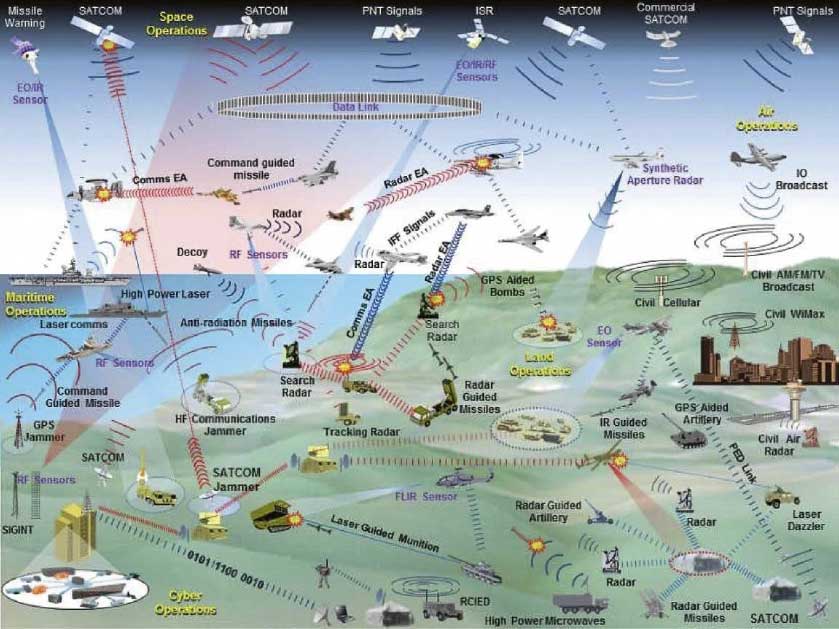
The first step in controlling the spectrum is to develop a methodology to manage the frequencies being used. Spectrum Management (SM), broadly defined, is the oversight and planning of frequency use to mitigate conflict and maximize utilization. EW can no longer be done without spectrum management. Any future combat scenario – whether EW is employed or not – will experience a conflict in frequency utilization unless the spectrum is managed properly. Frequency assignments and plans must be managed ahead of time and then employed with precision. Spectrum Management is coalescing with EW to become the cornerstone of the future force.
3. Electromagnetic Spectrum Operations – EMSO
Since EW can no longer be done without spectrum management, a new lexicon has emerged onto the scene: Electromagnetic Spectrum Operations, or EMSO. Mathematically, this can be represented by EW + SM = EMSO. JP 3-85 defines EMSO as “coordinated military actions to exploit, attack, protect, and manage the electromagnetic environment.” Both JP 3-85 and the 2020 DoD EMS Superiority Strategy both state that “EW” is one part of EMSO, the other part being the spectrum management operations[1].
I am finding it more and more relevant to use the term, “EW,” when I am referring to Electromagnetic Attack or Electromagnetic Support. I am finding it more and more appropriate to use the term, “EMSO,” when I am speaking of anything other than that. In the next blog, I will go into more detail about EP, spectrum management and their coalescing roles in military operations through the emergence of and growing dependence on spectrum-dependent systems.
4. Electromagnetic Battle Management – EMBM
JP 3-85 explains EMBM as, “The dynamic monitoring, assessing, planning, and directing of operations in the electromagnetic spectrum in support of the commander’s concept of the operation.”[2] I’d like to break this down to some simpler concepts, because it is really important to understand it for future military operations.
It is best to think about EMBM as a network of sensors. Types of sensors that make up this battle management network include tablets, cell phones, ruggedized laptops (e.g., EWPMT[3]), Android Blue Force Trackers, GPS devices, and generalized non-EW systems such as data link and voice/comms radios. It is these systems that will make EMBM possible.
The EMBM network is intended to do two very important things: collect signal, environmental, and troop data in the live battlefield and transmit it to a remotely located operations center (OC). To accomplish this, the sensors must be “controlled” using sophisticated network protocols; Command and Control (C2) of the sensors, if you will.
These two actions – collect and transmit – are undeniably 100% dependent on access to the EMS. There is a daunting challenge emerging for the DoD because EP features have been granted waivers year after year, so these sensor systems are not fortified to penetrate the complex EMOE. That is a subject for another blog, but please keep it in the back of your mind…
Conceptually, EMBM supports all actions across air, ground, maritime, and space in exploiting the EMS to project and sustain combat power while denying the adversary’s capability to project their combat power. At this time, EMBM is being addressed by each branch of service independently (Army = EWPMT; Navy = EMW; Air Force, ABMS). Hopefully, one day, EMBM will be developed to connect sensors and warfighters from all the military services into a single network.
So how are EMSO and EMBM intertwined? It is a simple chicken and egg relationship ?. To command and control sensors in the network, one must have a firm grasp on spectrum management – a plan and procedure to utilize frequencies in the spectrum. To do spectrum management, one must use the sensors in EMBM to read the spectrum and know what signals are currently active. Then, one must use the protocols in the EMBM network to command and control the devices in the battlefield to ensure they are properly utilizing their assigned frequencies. Well, on second thought, maybe this isn’t such a simple chicken and egg relationship, but it is necessary to have a keen grasp on this interplay of devices and frequencies.
EMBM will exist at every echelon level and in every physical domain. Every warfighter engaged in combat will have a role in EMBM. EMBM enables spectrum warfare. EMBM makes it possible for wartime commanders to know what assets and situations they have at their disposal. It is EMBM that will make Joint, All-Domain Command and Control (JADC2)[4] possible.
5. Joint, All-Domain Command and Control – JADC2
As mentioned previously, the thousands of sensors that make up EMBM in the battlefield are charged with obtaining situational awareness data and transmitting it to a remote location. The successful transmission of this data is intended to paint a comprehensive and accurate situational awareness (SA) picture of the spectrum battlefield. It generates “heat maps,” which are terrain images overlaid with signal footprints, like the one shown in the figure below.
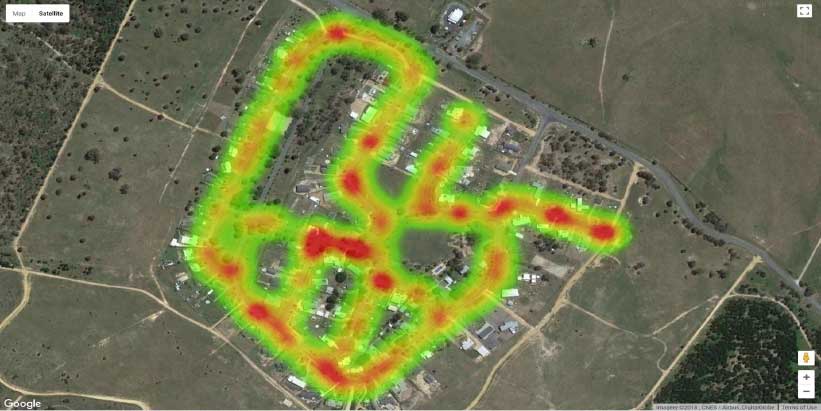
Figure 1- Photo Courtesy of https://wjmccann.github.io/blog/2018/04/06/Wardriving-433
Having a comprehensive situational awareness (SA) picture will give commanders the information they need to make command decisions. This SA picture will be synthesized and displayed in an operations center, like the one depicted in Figure 2.
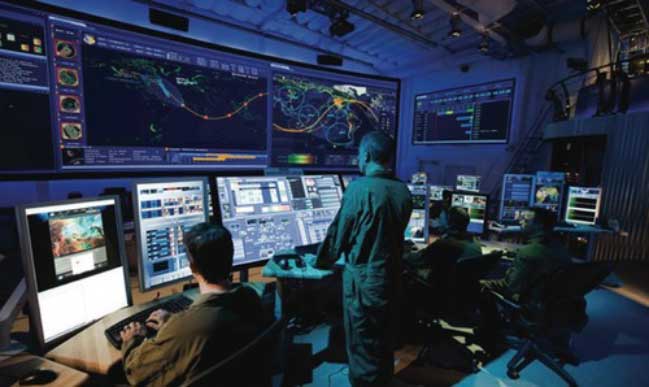
Figure 2 – Photo credit: nationaldefensemagazine.org
JADC2 is intended to present the situational awareness pictures being generated by EMBM in the operations centers around the globe. These operations centers will be manned by combat commanders who monitor the spectrum and joint forces deployed in the Area of Responsibility (AOR) It will enable those commanders to issue direction from anywhere in the world and impart control to any troop or device in a remote battlefield, all entirely through the EMS. It is JADC2 that will make Multi-Domain Operations (MDO) possible.
6. Multi-Domain Operations – MDO (a.k.a. All-Domain Operations (ADO))
The intent of MDO is leverage the capabilities of JADC2 to issue commands to and impart control on military assets across all domains. Once JADC2 capabilities are in place, then the DoD can conduct MDO effectively, using both kinetic and non-kinetic solutions in an integrated portfolio of combat options to the operational commander. These non-kinetic solutions reside in the EMS and are made entirely possible because of our continued and assured access to the EMS.
In the future battlefield, commanders will be making command and control decisions from a potentially far away location, all through the EMS. This means they will have knowledge of all assets in an AOR, and they will have the ability to “instruct” those assets to, for example, launch a GPS-guided munition, jam a target, or spoof a tracking radar. This capability is completely novel and completely essential to the future fight.
The future battlespace will require unfettered access to the EMS to manifest effective and accurate EMBM (situational awareness) to enable JADC2 (remote command and control) to make MDO possible.


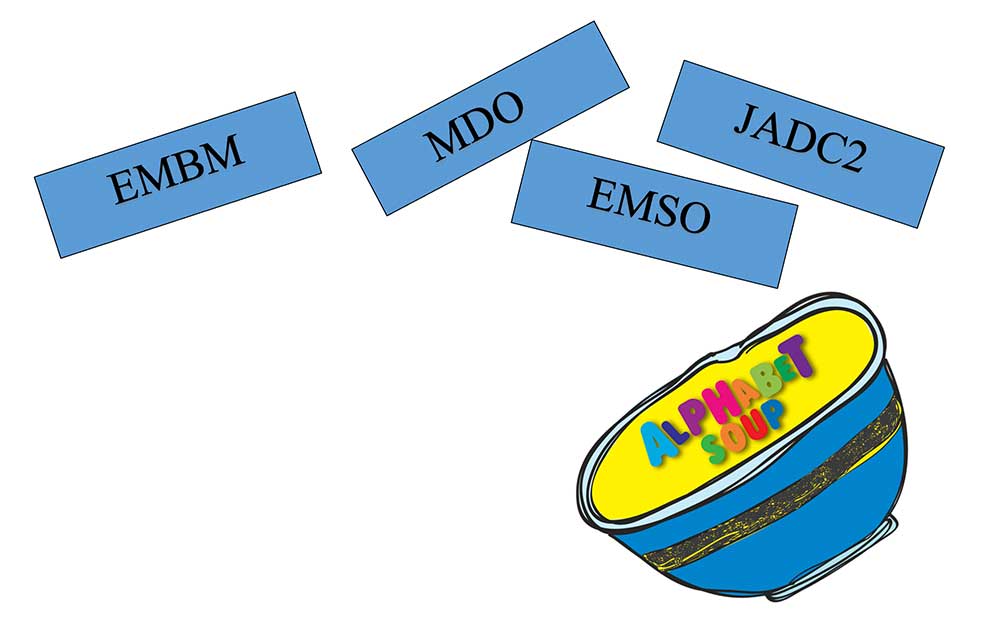
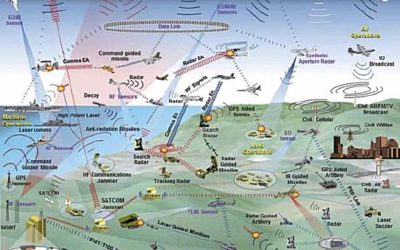


0 Comments